wheel GMC SIERRA 2005 Manual PDF
[x] Cancel search | Manufacturer: GMC, Model Year: 2005, Model line: SIERRA, Model: GMC SIERRA 2005Pages: 574, PDF Size: 2.95 MB
Page 357 of 574
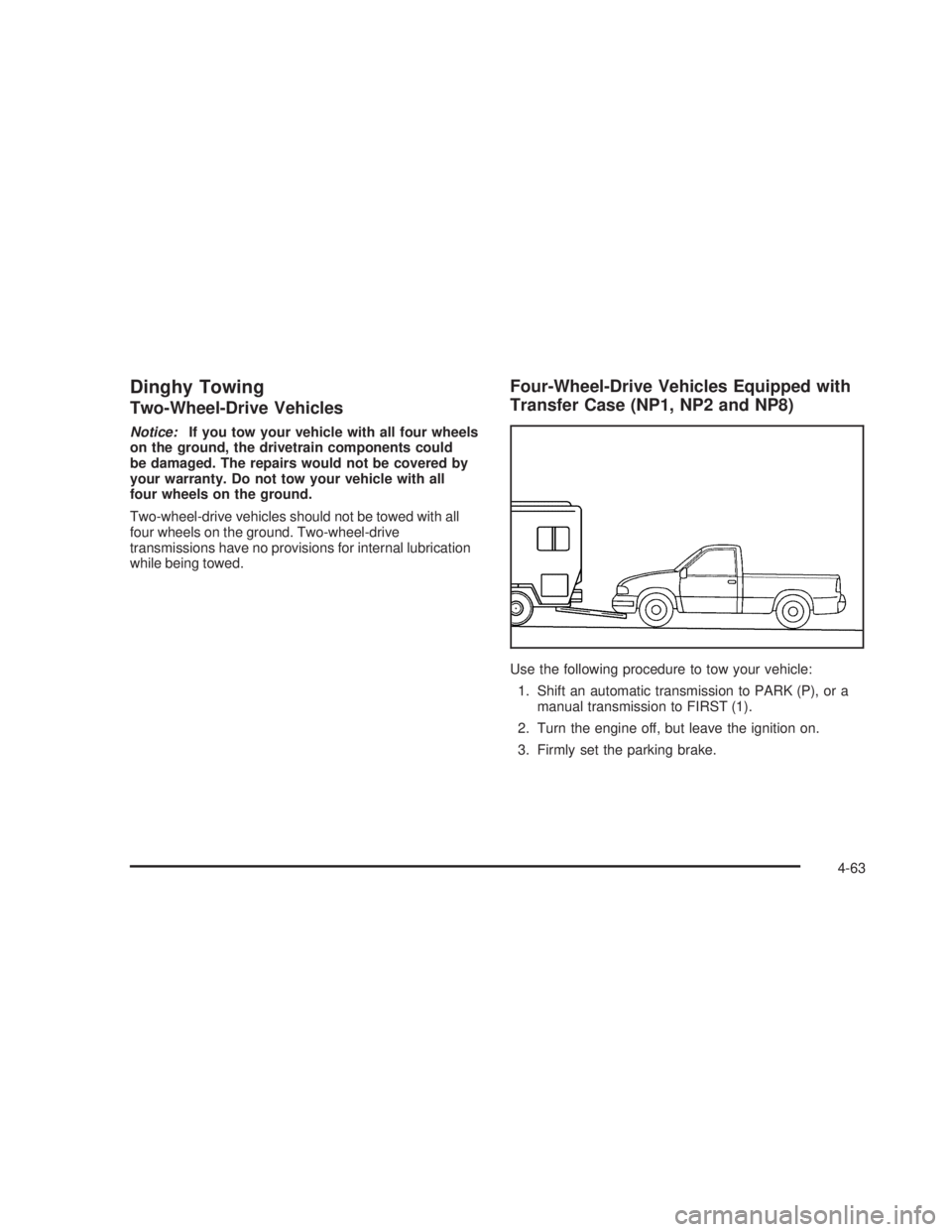
Dinghy Towing
Two-Wheel-Drive Vehicles
Notice:If you tow your vehicle with all four wheels
on the ground, the drivetrain components could
be damaged. The repairs would not be covered by
your warranty. Do not tow your vehicle with all
four wheels on the ground.
Two-wheel-drive vehicles should not be towed with all
four wheels on the ground. Two-wheel-drive
transmissions have no provisions for internal lubrication
while being towed.
Four-Wheel-Drive Vehicles Equipped with
Transfer Case (NP1, NP2 and NP8)
Use the following procedure to tow your vehicle:
1. Shift an automatic transmission to PARK (P), or a
manual transmission to FIRST (1).
2. Turn the engine off, but leave the ignition on.
3. Firmly set the parking brake.
4-63
Page 358 of 574
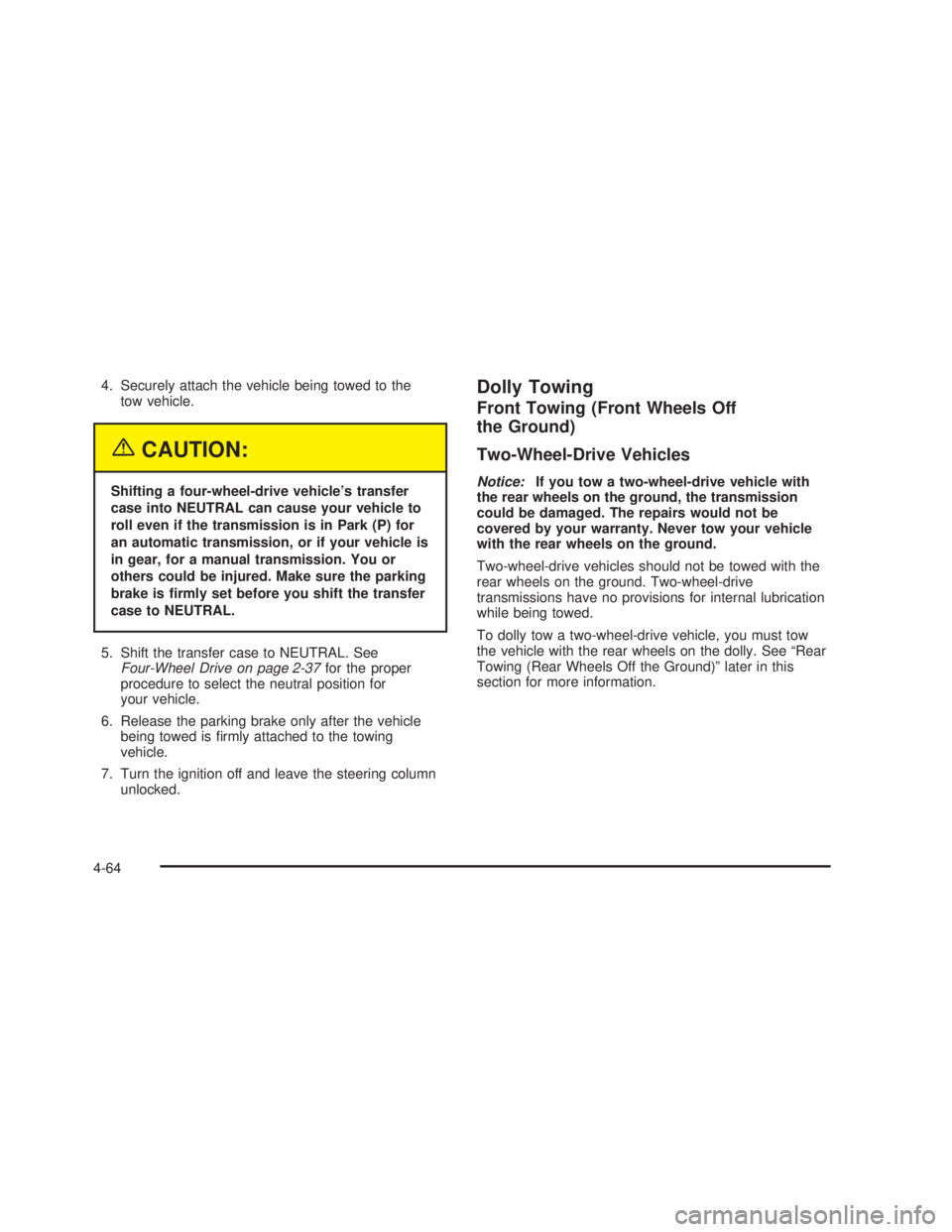
4. Securely attach the vehicle being towed to the
tow vehicle.
{CAUTION:
Shifting a four-wheel-drive vehicle’s transfer
case into NEUTRAL can cause your vehicle to
roll even if the transmission is in Park (P) for
an automatic transmission, or if your vehicle is
in gear, for a manual transmission. You or
others could be injured. Make sure the parking
brake is �rmly set before you shift the transfer
case to NEUTRAL.
5. Shift the transfer case to NEUTRAL. See
Four-Wheel Drive on page 2-37for the proper
procedure to select the neutral position for
your vehicle.
6. Release the parking brake only after the vehicle
being towed is �rmly attached to the towing
vehicle.
7. Turn the ignition off and leave the steering column
unlocked.
Dolly Towing
Front Towing (Front Wheels Off
the Ground)
Two-Wheel-Drive Vehicles
Notice:If you tow a two-wheel-drive vehicle with
the rear wheels on the ground, the transmission
could be damaged. The repairs would not be
covered by your warranty. Never tow your vehicle
with the rear wheels on the ground.
Two-wheel-drive vehicles should not be towed with the
rear wheels on the ground. Two-wheel-drive
transmissions have no provisions for internal lubrication
while being towed.
To dolly tow a two-wheel-drive vehicle, you must tow
the vehicle with the rear wheels on the dolly. See “Rear
Towing (Rear Wheels Off the Ground)” later in this
section for more information.
4-64
Page 359 of 574
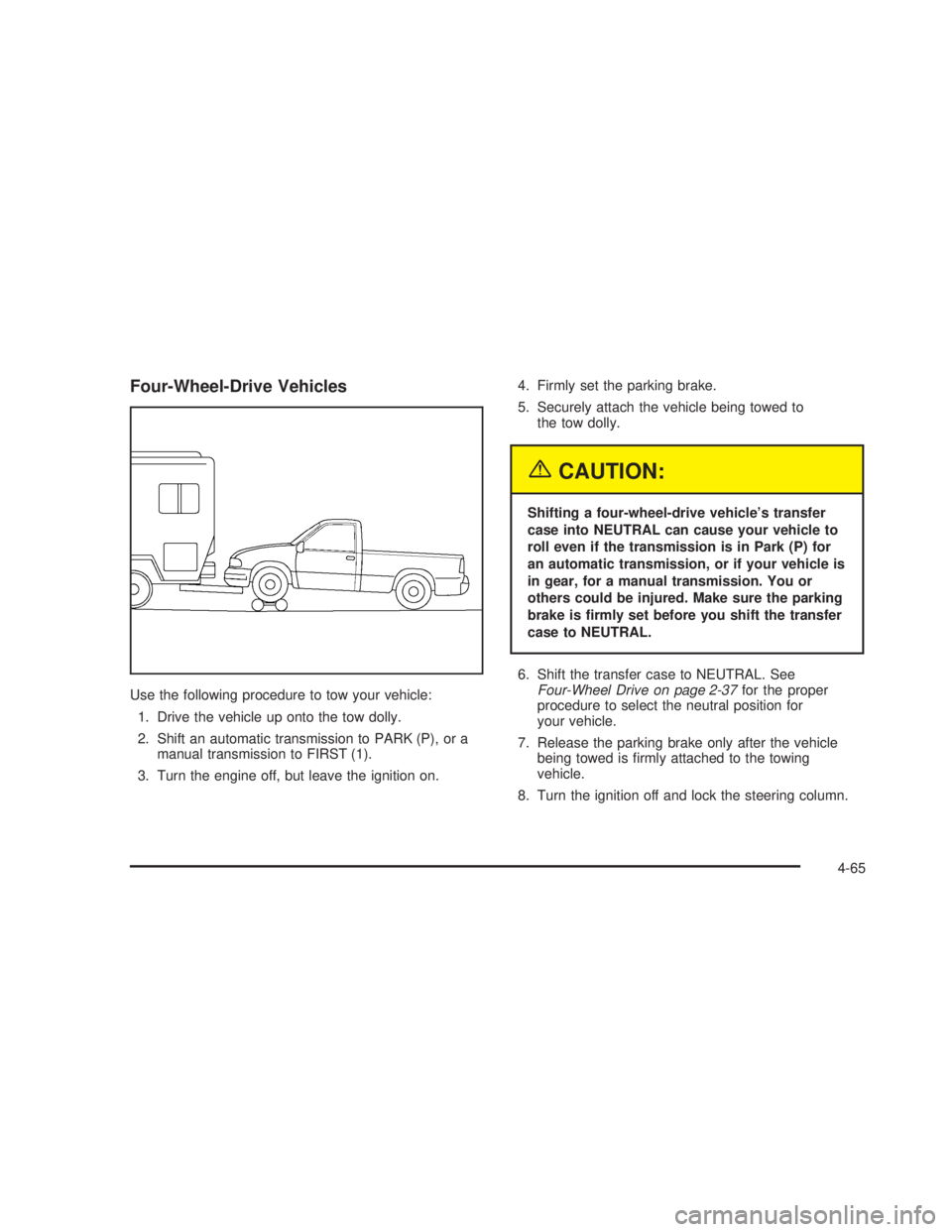
Four-Wheel-Drive Vehicles
Use the following procedure to tow your vehicle:
1. Drive the vehicle up onto the tow dolly.
2. Shift an automatic transmission to PARK (P), or a
manual transmission to FIRST (1).
3. Turn the engine off, but leave the ignition on.4. Firmly set the parking brake.
5. Securely attach the vehicle being towed to
the tow dolly.
{CAUTION:
Shifting a four-wheel-drive vehicle’s transfer
case into NEUTRAL can cause your vehicle to
roll even if the transmission is in Park (P) for
an automatic transmission, or if your vehicle is
in gear, for a manual transmission. You or
others could be injured. Make sure the parking
brake is �rmly set before you shift the transfer
case to NEUTRAL.
6. Shift the transfer case to NEUTRAL. See
Four-Wheel Drive on page 2-37for the proper
procedure to select the neutral position for
your vehicle.
7. Release the parking brake only after the vehicle
being towed is �rmly attached to the towing
vehicle.
8. Turn the ignition off and lock the steering column.
4-65
Page 360 of 574
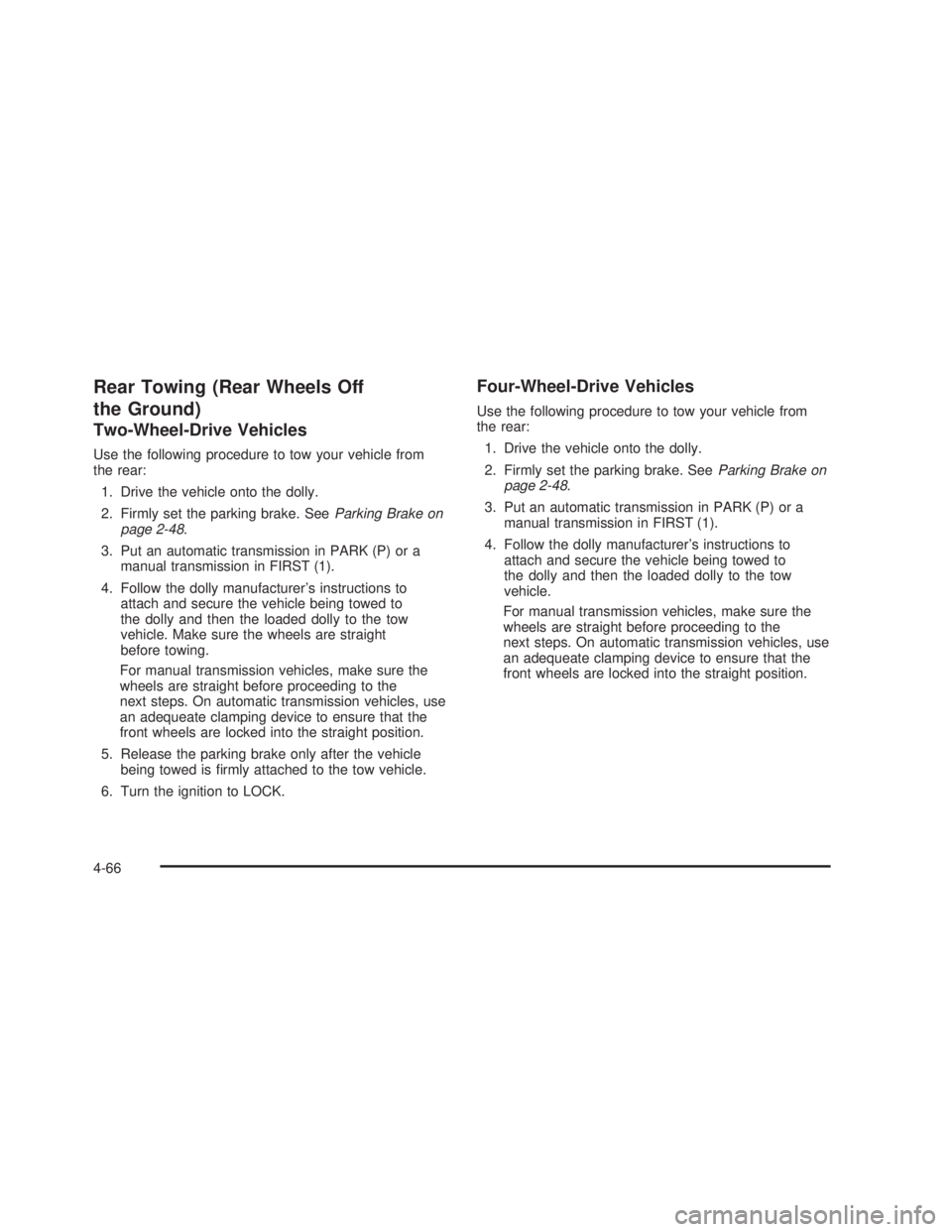
Rear Towing (Rear Wheels Off
the Ground)
Two-Wheel-Drive Vehicles
Use the following procedure to tow your vehicle from
the rear:
1. Drive the vehicle onto the dolly.
2. Firmly set the parking brake. SeeParking Brake on
page 2-48.
3. Put an automatic transmission in PARK (P) or a
manual transmission in FIRST (1).
4. Follow the dolly manufacturer’s instructions to
attach and secure the vehicle being towed to
the dolly and then the loaded dolly to the tow
vehicle. Make sure the wheels are straight
before towing.
For manual transmission vehicles, make sure the
wheels are straight before proceeding to the
next steps. On automatic transmission vehicles, use
an adequeate clamping device to ensure that the
front wheels are locked into the straight position.
5. Release the parking brake only after the vehicle
being towed is �rmly attached to the tow vehicle.
6. Turn the ignition to LOCK.
Four-Wheel-Drive Vehicles
Use the following procedure to tow your vehicle from
the rear:
1. Drive the vehicle onto the dolly.
2. Firmly set the parking brake. SeeParking Brake on
page 2-48.
3. Put an automatic transmission in PARK (P) or a
manual transmission in FIRST (1).
4. Follow the dolly manufacturer’s instructions to
attach and secure the vehicle being towed to
the dolly and then the loaded dolly to the tow
vehicle.
For manual transmission vehicles, make sure the
wheels are straight before proceeding to the
next steps. On automatic transmission vehicles, use
an adequeate clamping device to ensure that the
front wheels are locked into the straight position.
4-66
Page 361 of 574
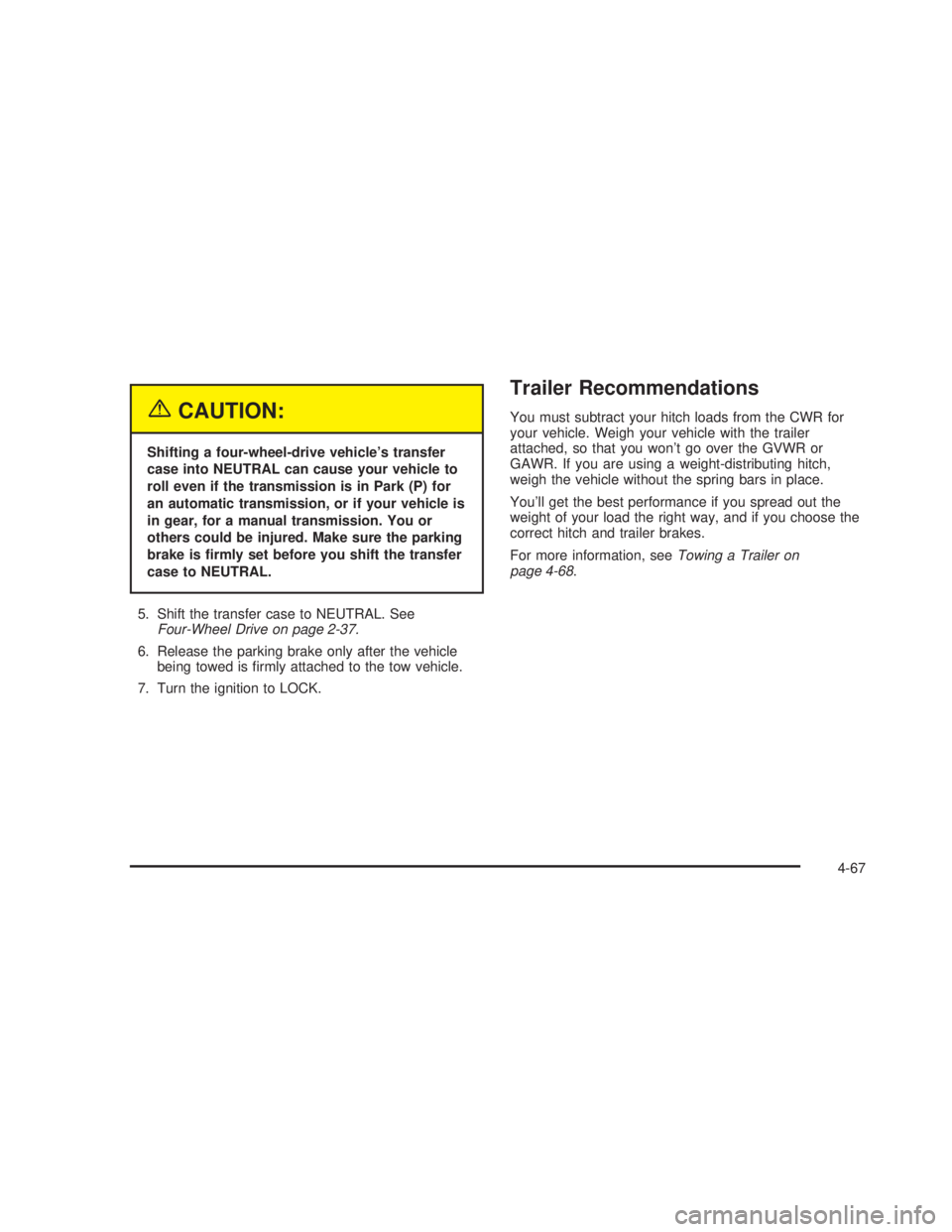
{CAUTION:
Shifting a four-wheel-drive vehicle’s transfer
case into NEUTRAL can cause your vehicle to
roll even if the transmission is in Park (P) for
an automatic transmission, or if your vehicle is
in gear, for a manual transmission. You or
others could be injured. Make sure the parking
brake is �rmly set before you shift the transfer
case to NEUTRAL.
5. Shift the transfer case to NEUTRAL. See
Four-Wheel Drive on page 2-37.
6. Release the parking brake only after the vehicle
being towed is �rmly attached to the tow vehicle.
7. Turn the ignition to LOCK.
Trailer Recommendations
You must subtract your hitch loads from the CWR for
your vehicle. Weigh your vehicle with the trailer
attached, so that you won’t go over the GVWR or
GAWR. If you are using a weight-distributing hitch,
weigh the vehicle without the spring bars in place.
You’ll get the best performance if you spread out the
weight of your load the right way, and if you choose the
correct hitch and trailer brakes.
For more information, seeTowing a Trailer on
page 4-68.
4-67
Page 365 of 574
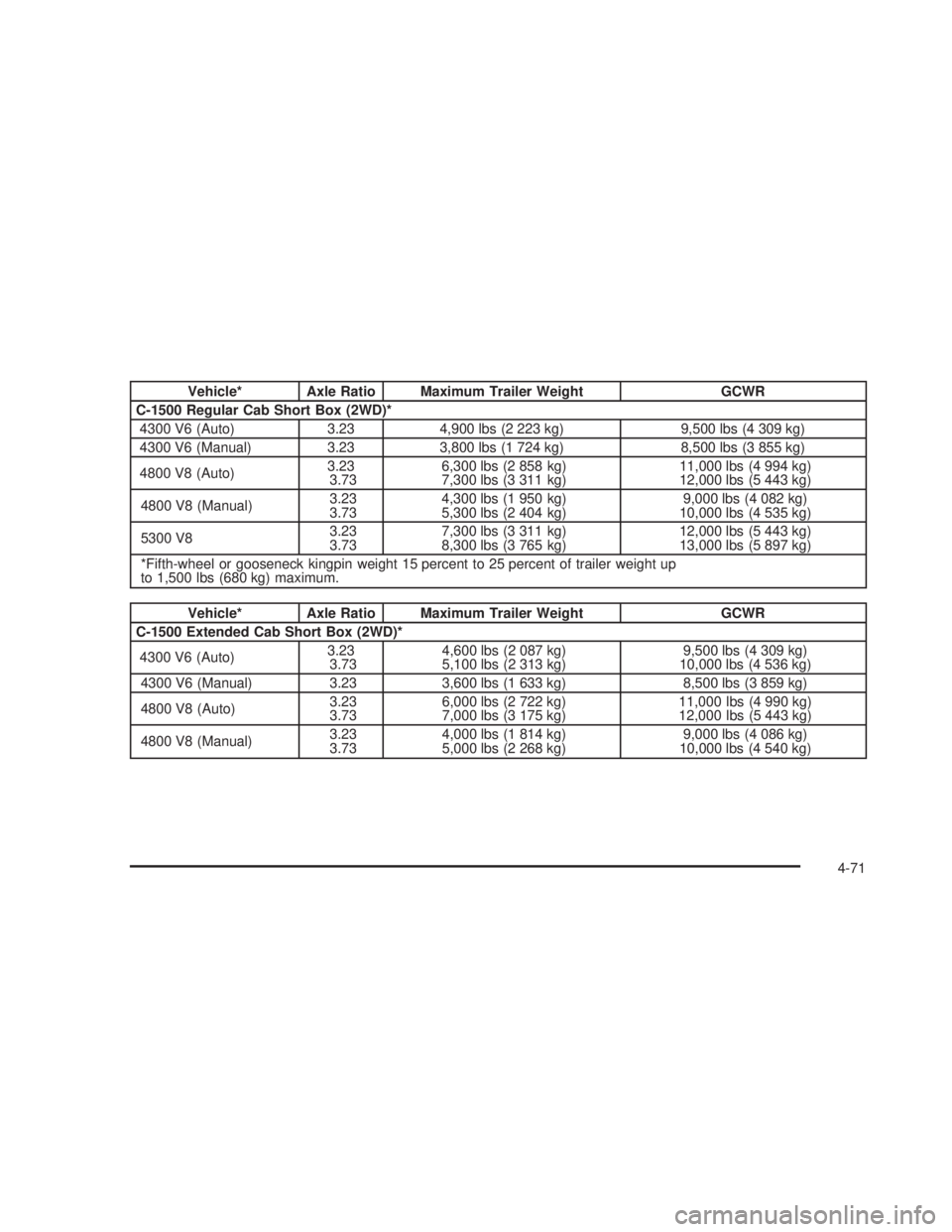
Vehicle* Axle Ratio Maximum Trailer Weight GCWR
C-1500 Regular Cab Short Box (2WD)*
4300 V6 (Auto) 3.23 4,900 lbs (2 223 kg) 9,500 lbs (4 309 kg)
4300 V6 (Manual) 3.23 3,800 lbs (1 724 kg) 8,500 lbs (3 855 kg)
4800 V8 (Auto)3.23
3.736,300 lbs (2 858 kg)
7,300 lbs (3 311 kg)11,000 lbs (4 994 kg)
12,000 lbs (5 443 kg)
4800 V8 (Manual)3.23
3.734,300 lbs (1 950 kg)
5,300 lbs (2 404 kg)9,000 lbs (4 082 kg)
10,000 lbs (4 535 kg)
5300 V83.23
3.737,300 lbs (3 311 kg)
8,300 lbs (3 765 kg)12,000 lbs (5 443 kg)
13,000 lbs (5 897 kg)
*Fifth-wheel or gooseneck kingpin weight 15 percent to 25 percent of trailer weight up
to 1,500 lbs (680 kg) maximum.
Vehicle* Axle Ratio Maximum Trailer Weight GCWR
C-1500 Extended Cab Short Box (2WD)*
4300 V6 (Auto)3.23
3.734,600 lbs (2 087 kg)
5,100 lbs (2 313 kg)9,500 lbs (4 309 kg)
10,000 lbs (4 536 kg)
4300 V6 (Manual) 3.23 3,600 lbs (1 633 kg) 8,500 lbs (3 859 kg)
4800 V8 (Auto)3.23
3.736,000 lbs (2 722 kg)
7,000 lbs (3 175 kg)11,000 lbs (4 990 kg)
12,000 lbs (5 443 kg)
4800 V8 (Manual)3.23
3.734,000 lbs (1 814 kg)
5,000 lbs (2 268 kg)9,000 lbs (4 086 kg)
10,000 lbs (4 540 kg)
4-71
Page 366 of 574
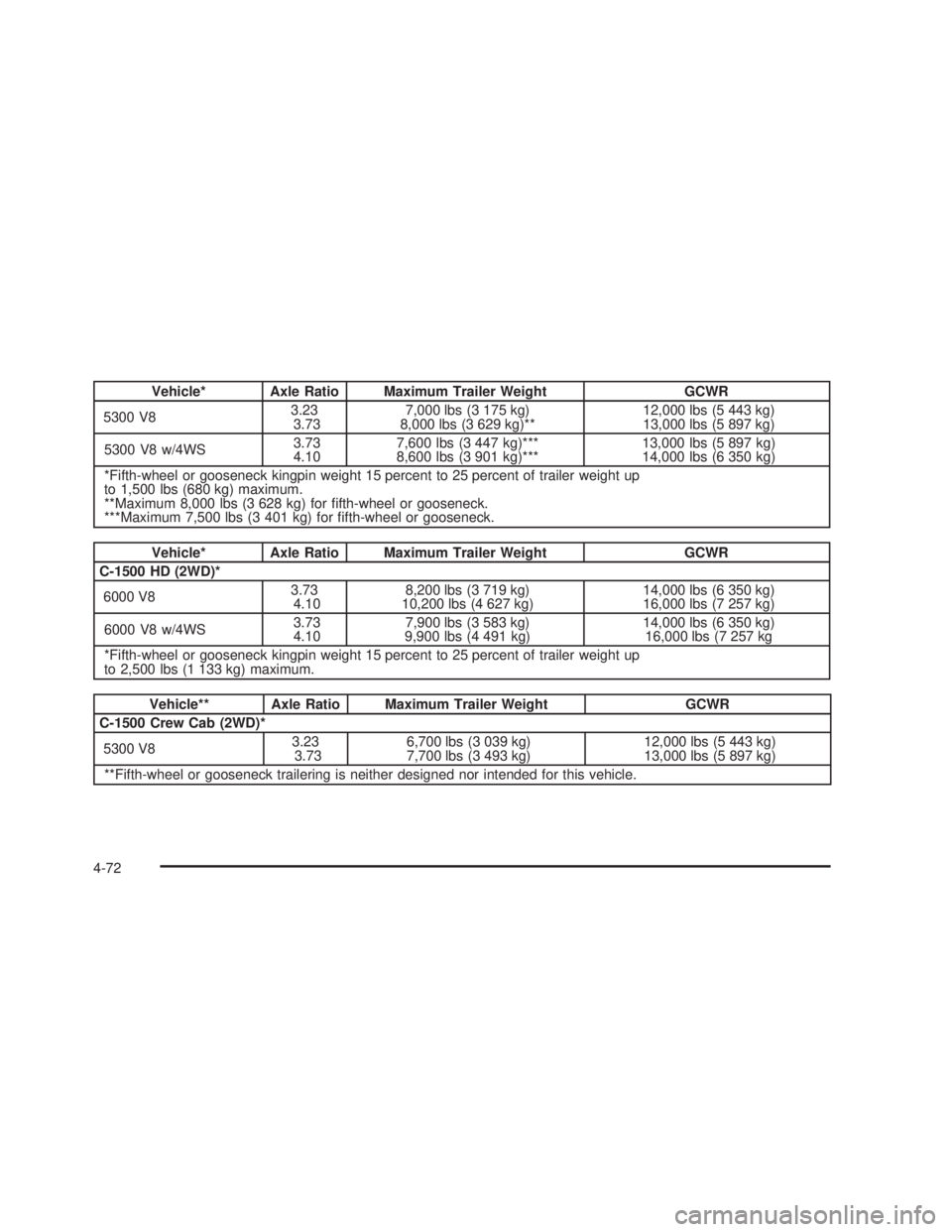
Vehicle* Axle Ratio Maximum Trailer Weight GCWR
5300 V83.23
3.737,000 lbs (3 175 kg)
8,000 lbs (3 629 kg)**12,000 lbs (5 443 kg)
13,000 lbs (5 897 kg)
5300 V8 w/4WS3.73
4.107,600 lbs (3 447 kg)***
8,600 lbs (3 901 kg)***13,000 lbs (5 897 kg)
14,000 lbs (6 350 kg)
*Fifth-wheel or gooseneck kingpin weight 15 percent to 25 percent of trailer weight up
to 1,500 lbs (680 kg) maximum.
**Maximum 8,000 lbs (3 628 kg) for �fth-wheel or gooseneck.
***Maximum 7,500 lbs (3 401 kg) for �fth-wheel or gooseneck.
Vehicle* Axle Ratio Maximum Trailer Weight GCWR
C-1500 HD (2WD)*
6000 V83.73
4.108,200 lbs (3 719 kg)
10,200 lbs (4 627 kg)14,000 lbs (6 350 kg)
16,000 lbs (7 257 kg)
6000 V8 w/4WS3.73
4.107,900 lbs (3 583 kg)
9,900 lbs (4 491 kg)14,000 lbs (6 350 kg)
16,000 lbs (7 257 kg
*Fifth-wheel or gooseneck kingpin weight 15 percent to 25 percent of trailer weight up
to 2,500 lbs (1 133 kg) maximum.
Vehicle** Axle Ratio Maximum Trailer Weight GCWR
C-1500 Crew Cab (2WD)*
5300 V83.23
3.736,700 lbs (3 039 kg)
7,700 lbs (3 493 kg)12,000 lbs (5 443 kg)
13,000 lbs (5 897 kg)
**Fifth-wheel or gooseneck trailering is neither designed nor intended for this vehicle.
4-72
Page 367 of 574
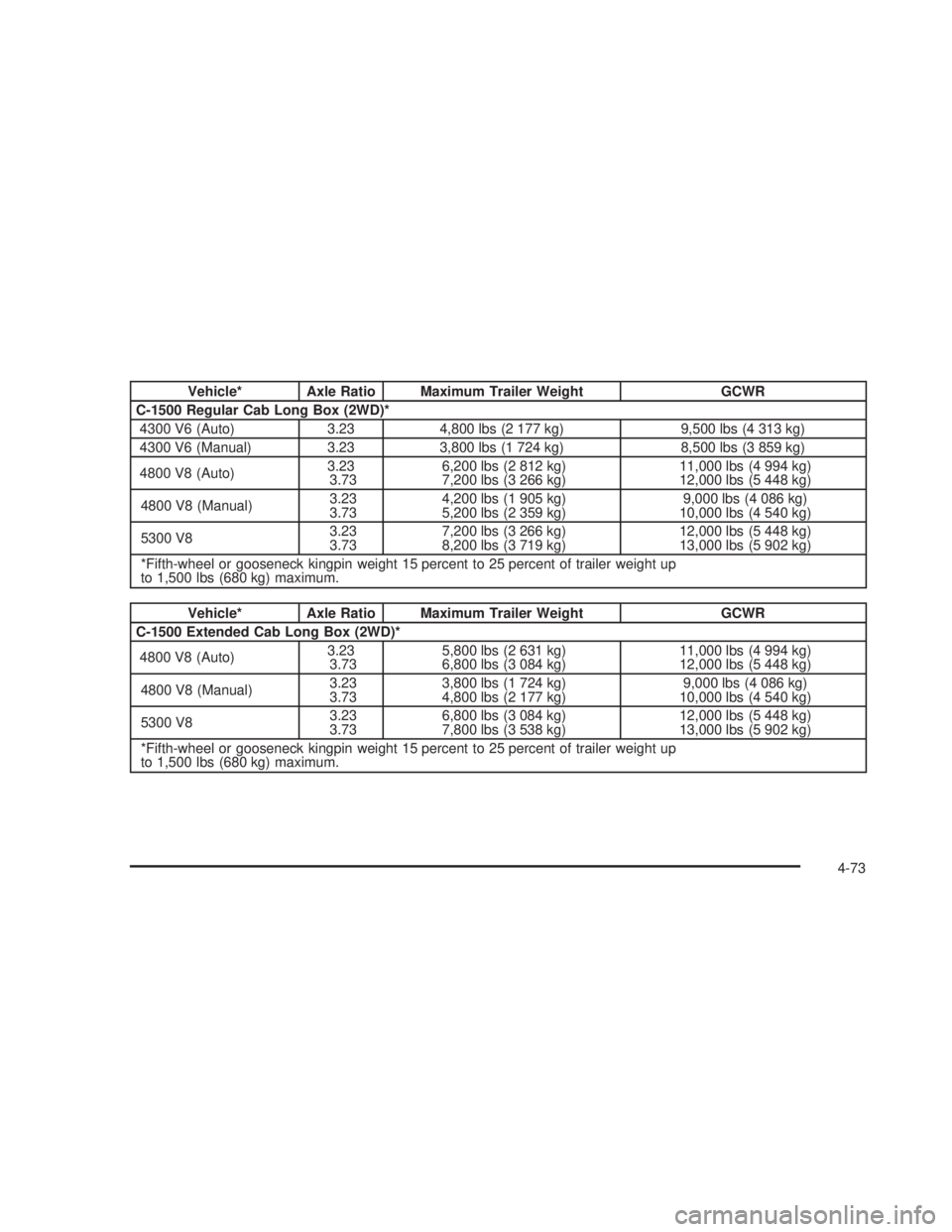
Vehicle* Axle Ratio Maximum Trailer Weight GCWR
C-1500 Regular Cab Long Box (2WD)*
4300 V6 (Auto) 3.23 4,800 lbs (2 177 kg) 9,500 lbs (4 313 kg)
4300 V6 (Manual) 3.23 3,800 lbs (1 724 kg) 8,500 lbs (3 859 kg)
4800 V8 (Auto)3.23
3.736,200 lbs (2 812 kg)
7,200 lbs (3 266 kg)11,000 lbs (4 994 kg)
12,000 lbs (5 448 kg)
4800 V8 (Manual)3.23
3.734,200 lbs (1 905 kg)
5,200 lbs (2 359 kg)9,000 lbs (4 086 kg)
10,000 lbs (4 540 kg)
5300 V83.23
3.737,200 lbs (3 266 kg)
8,200 lbs (3 719 kg)12,000 lbs (5 448 kg)
13,000 lbs (5 902 kg)
*Fifth-wheel or gooseneck kingpin weight 15 percent to 25 percent of trailer weight up
to 1,500 lbs (680 kg) maximum.
Vehicle* Axle Ratio Maximum Trailer Weight GCWR
C-1500 Extended Cab Long Box (2WD)*
4800 V8 (Auto)3.23
3.735,800 lbs (2 631 kg)
6,800 lbs (3 084 kg)11,000 lbs (4 994 kg)
12,000 lbs (5 448 kg)
4800 V8 (Manual)3.23
3.733,800 lbs (1 724 kg)
4,800 lbs (2 177 kg)9,000 lbs (4 086 kg)
10,000 lbs (4 540 kg)
5300 V83.23
3.736,800 lbs (3 084 kg)
7,800 lbs (3 538 kg)12,000 lbs (5 448 kg)
13,000 lbs (5 902 kg)
*Fifth-wheel or gooseneck kingpin weight 15 percent to 25 percent of trailer weight up
to 1,500 lbs (680 kg) maximum.
4-73
Page 368 of 574
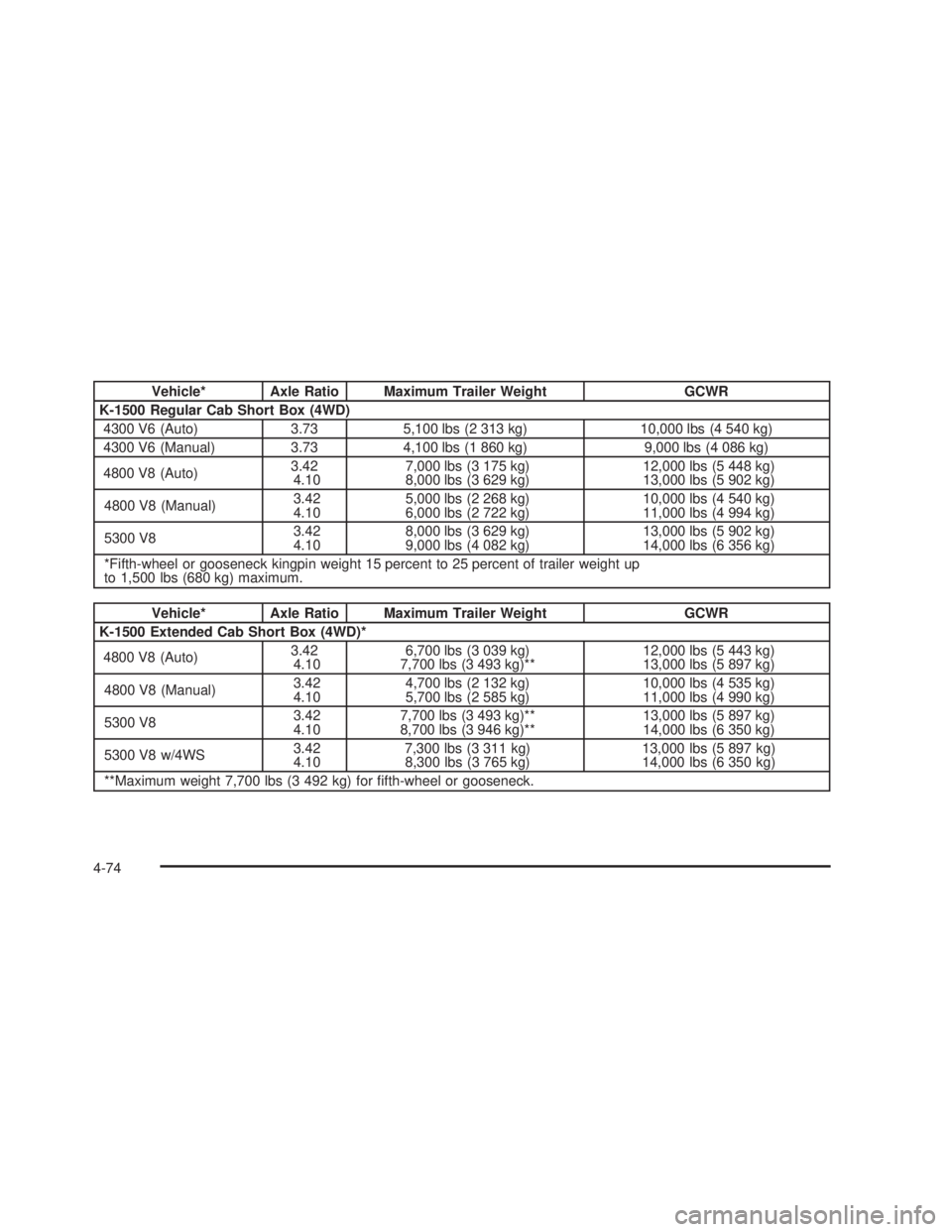
Vehicle* Axle Ratio Maximum Trailer Weight GCWR
K-1500 Regular Cab Short Box (4WD)
4300 V6 (Auto) 3.73 5,100 lbs (2 313 kg) 10,000 lbs (4 540 kg)
4300 V6 (Manual) 3.73 4,100 lbs (1 860 kg) 9,000 lbs (4 086 kg)
4800 V8 (Auto)3.42
4.107,000 lbs (3 175 kg)
8,000 lbs (3 629 kg)12,000 lbs (5 448 kg)
13,000 lbs (5 902 kg)
4800 V8 (Manual)3.42
4.105,000 lbs (2 268 kg)
6,000 lbs (2 722 kg)10,000 lbs (4 540 kg)
11,000 lbs (4 994 kg)
5300 V83.42
4.108,000 lbs (3 629 kg)
9,000 lbs (4 082 kg)13,000 lbs (5 902 kg)
14,000 lbs (6 356 kg)
*Fifth-wheel or gooseneck kingpin weight 15 percent to 25 percent of trailer weight up
to 1,500 lbs (680 kg) maximum.
Vehicle* Axle Ratio Maximum Trailer Weight GCWR
K-1500 Extended Cab Short Box (4WD)*
4800 V8 (Auto)3.42
4.106,700 lbs (3 039 kg)
7,700 lbs (3 493 kg)**12,000 lbs (5 443 kg)
13,000 lbs (5 897 kg)
4800 V8 (Manual)3.42
4.104,700 lbs (2 132 kg)
5,700 lbs (2 585 kg)10,000 lbs (4 535 kg)
11,000 lbs (4 990 kg)
5300 V83.42
4.107,700 lbs (3 493 kg)**
8,700 lbs (3 946 kg)**13,000 lbs (5 897 kg)
14,000 lbs (6 350 kg)
5300 V8 w/4WS3.42
4.107,300 lbs (3 311 kg)
8,300 lbs (3 765 kg)13,000 lbs (5 897 kg)
14,000 lbs (6 350 kg)
**Maximum weight 7,700 lbs (3 492 kg) for �fth-wheel or gooseneck.
4-74
Page 369 of 574
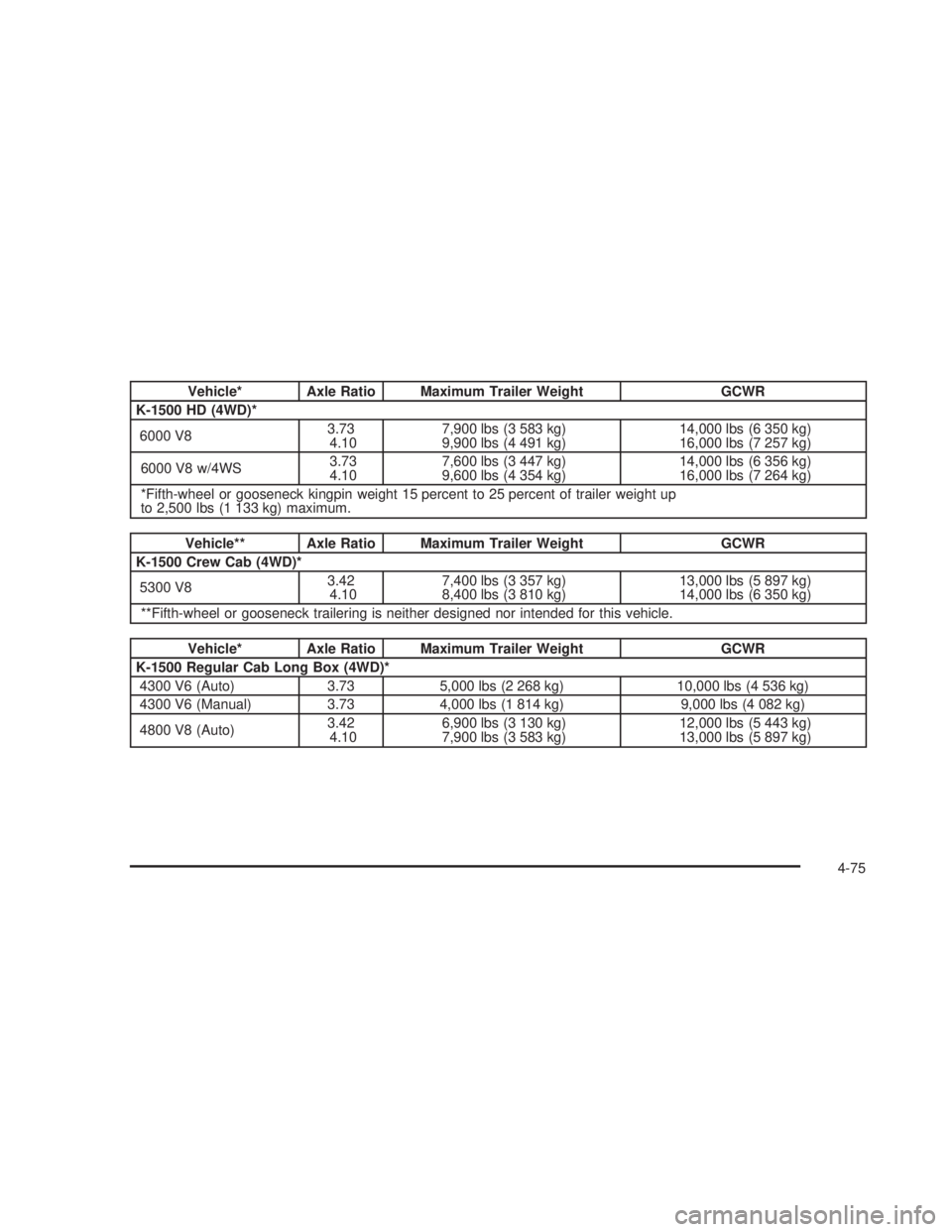
Vehicle* Axle Ratio Maximum Trailer Weight GCWR
K-1500 HD (4WD)*
6000 V83.73
4.107,900 lbs (3 583 kg)
9,900 lbs (4 491 kg)14,000 lbs (6 350 kg)
16,000 lbs (7 257 kg)
6000 V8 w/4WS3.73
4.107,600 lbs (3 447 kg)
9,600 lbs (4 354 kg)14,000 lbs (6 356 kg)
16,000 lbs (7 264 kg)
*Fifth-wheel or gooseneck kingpin weight 15 percent to 25 percent of trailer weight up
to 2,500 lbs (1 133 kg) maximum.
Vehicle** Axle Ratio Maximum Trailer Weight GCWR
K-1500 Crew Cab (4WD)*
5300 V83.42
4.107,400 lbs (3 357 kg)
8,400 lbs (3 810 kg)13,000 lbs (5 897 kg)
14,000 lbs (6 350 kg)
**Fifth-wheel or gooseneck trailering is neither designed nor intended for this vehicle.
Vehicle* Axle Ratio Maximum Trailer Weight GCWR
K-1500 Regular Cab Long Box (4WD)*
4300 V6 (Auto) 3.73 5,000 lbs (2 268 kg) 10,000 lbs (4 536 kg)
4300 V6 (Manual) 3.73 4,000 lbs (1 814 kg) 9,000 lbs (4 082 kg)
4800 V8 (Auto)3.42
4.106,900 lbs (3 130 kg)
7,900 lbs (3 583 kg)12,000 lbs (5 443 kg)
13,000 lbs (5 897 kg)
4-75